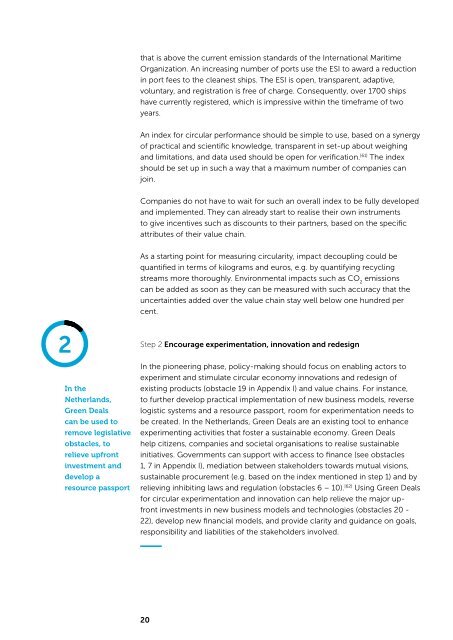Unleashing the Power of the Circular Economy
Unleashing the Power of the Circular Economy
Unleashing the Power of the Circular Economy
You also want an ePaper? Increase the reach of your titles
YUMPU automatically turns print PDFs into web optimized ePapers that Google loves.
2<br />
2<br />
In <strong>the</strong><br />
Ne<strong>the</strong>rlands,<br />
Green Deals<br />
can be used to<br />
remove legislative<br />
obstacles, to<br />
relieve upfront<br />
investment and<br />
develop a<br />
resource passport<br />
that is above <strong>the</strong> current emission standards <strong>of</strong> <strong>the</strong> International Maritime<br />
Organization. An increasing number <strong>of</strong> ports use <strong>the</strong> ESI to award a reduction<br />
in port fees to <strong>the</strong> cleanest ships. The ESI is open, transparent, adaptive,<br />
voluntary, and registration is free <strong>of</strong> charge. Consequently, over 1700 ships<br />
have currently registered, which is impressive within <strong>the</strong> timeframe <strong>of</strong> two<br />
years.<br />
An index for circular performance should be simple to use, based on a synergy<br />
<strong>of</strong> practical and scientific knowledge, transparent in set-up about weighing<br />
and limitations, and data used should be open for verification. [61] The index<br />
should be set up in such a way that a maximum number <strong>of</strong> companies can<br />
join.<br />
Companies do not have to wait for such an overall index to be fully developed<br />
and implemented. They can already start to realise <strong>the</strong>ir own instruments<br />
to give incentives such as discounts to <strong>the</strong>ir partners, based on <strong>the</strong> specific<br />
attributes <strong>of</strong> <strong>the</strong>ir value chain.<br />
As a starting point for measuring circularity, impact decoupling could be<br />
quantified in terms <strong>of</strong> kilograms and euros, e.g. by quantifying recycling<br />
streams more thoroughly. Environmental impacts such as CO 2 emissions<br />
can be added as soon as <strong>the</strong>y can be measured with such accuracy that <strong>the</strong><br />
uncertainties added over <strong>the</strong> value chain stay well below one hundred per<br />
cent.<br />
Step 2 Encourage experimentation, innovation and redesign<br />
In <strong>the</strong> pioneering phase, policy-making should focus on enabling actors to<br />
experiment and stimulate circular economy innovations and redesign <strong>of</strong><br />
existing products (obstacle 19 in Appendix I) and value chains. For instance,<br />
to fur<strong>the</strong>r develop practical implementation <strong>of</strong> new business models, reverse<br />
logistic systems and a resource passport, room for experimentation needs to<br />
be created. In <strong>the</strong> Ne<strong>the</strong>rlands, Green Deals are an existing tool to enhance<br />
experimenting activities that foster a sustainable economy. Green Deals<br />
help citizens, companies and societal organisations to realise sustainable<br />
initiatives. Governments can support with access to finance (see obstacles<br />
1, 7 in Appendix I), mediation between stakeholders towards mutual visions,<br />
sustainable procurement (e.g. based on <strong>the</strong> index mentioned in step 1) and by<br />
relieving inhibiting laws and regulation (obstacles 6 – 10). [62] Using Green Deals<br />
for circular experimentation and innovation can help relieve <strong>the</strong> major upfront<br />
investments in new business models and technologies (obstacles 20 -<br />
22), develop new financial models, and provide clarity and guidance on goals,<br />
responsibility and liabilities <strong>of</strong> <strong>the</strong> stakeholders involved.<br />
20



